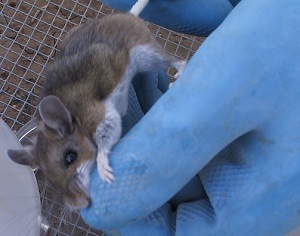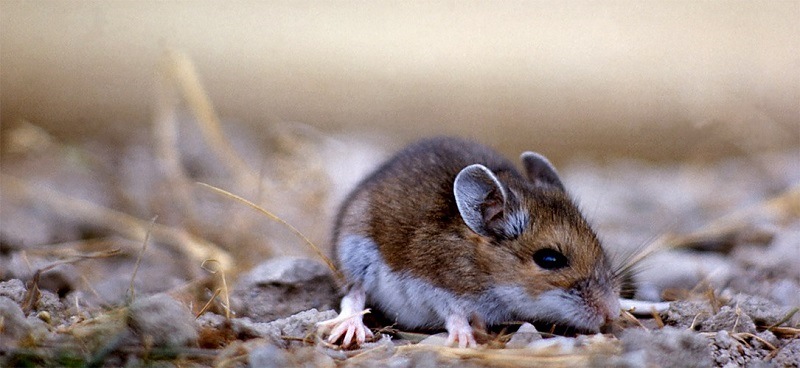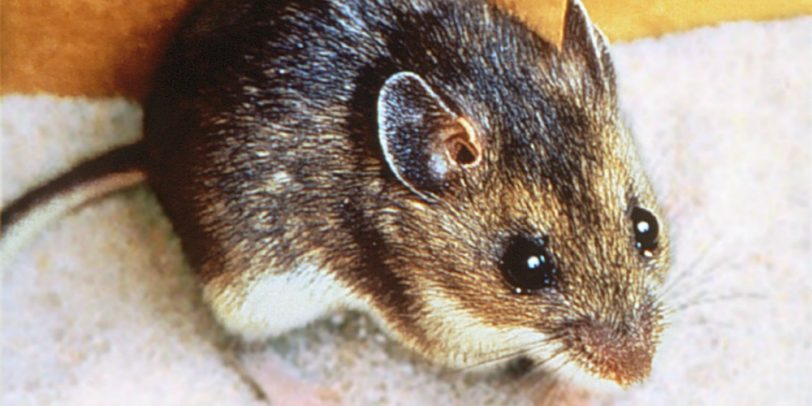Cute and Potentially Lethal
Deer mice are a subspecies of the New World Mouse, distant cousins of the house mouse and wharf rats. Small, they reach two to four inches, not including the tail.
All deer mice have a bicolored tail, and a white underbelly and feet. The top of their body is ordinarily brown but can be darker or lighter. They have big black eyes, and large ears, giving them good sight and hearing.
They are amazing jumpers and – due to their coloration – resemble a tiny deer. Living mostly outdoors, they will move inside when near inhabited areas, especially during severe weather.
Relatively solitary, the deer mouse forms a small den and forages over a short distance. Breeding as quickly as rodents do, the young create their own homes nearby, causing overlapping territories.
Being both nocturnal and sneaky, humans rarely see them. The droppings and nests you usually find are much less cute than the deer mice themselves. These nests are in homes year-round, often discovered during spring cleaning (after a deer mouse has holed up for the winter and is out searching for food).
How can something so adorable be such a serious problem?
Deer Mice are Disease-Spreading Vermin
The deer mouse bite can spread disease. More often, a disease is spread by contact with the feces, urine, saliva left behind, breathing in infected particles, or by fleas and ticks that live on them.
What sort of disease do they spread?
Lyme disease might be the nicest thing they cause. Deer mice can carry it and spread it to ticks.
Another disease spread by rodent dwelling parasites, The Plague, had its first confirmed human case in two decades just recently in Idaho. While deer mice may not be responsible for that one, rodents pass the carrying of diseases to each other.
Less Known Infections
Deer mice spread many lesser-known infections, including these two:
- Ehrlichiosis – another tickborne disease, this bacterial infection attacks and kills white blood cells.
- Babesiosis – similar to malaria and caused by blood parasites.
Deadly Hantavirus Pulmonary Syndrome (HPS)
 HPS, the form of the Hantavirus spread to humans by a deer mouse, keeps making the news. There were 31 confirmed cases of the disease before 1993 when first identified. Between then and January of 2017 there were 697 confirmed cases.
HPS, the form of the Hantavirus spread to humans by a deer mouse, keeps making the news. There were 31 confirmed cases of the disease before 1993 when first identified. Between then and January of 2017 there were 697 confirmed cases.
There is no cure or vaccine for the virus, and the fatality rate is 38%. It is hard to identify and harder to overcome without medical attention.
Reported Cases
All states except Hawaii and Alaska have reported cases of HPS.
- Washington – had three confirmed cases in Seattle in 2017 over a five-month period. Two cases in the same suburb were fatal. Another woman in a nearby city recovered.
- Colorado – confirmed a case in Denver in March of 2018.
- Oregon – In June of 2018, a woman from Redmond contracted the virus over the Memorial Day weekend and passed away.
What do I do if I See Evidence of a Deer Mouse?
You need a pest control professional to assess the area of concern. Contact Croach® to assist with eliminating a rodent infestation and sealing entrance points.
If you have flu-like symptoms – such as fever, intense muscle or head pain, fatigue, and nausea or vomiting – see a doctor. Remember, Hantavirus is not known to be spread by human contact.
What NOT To Do
- Do not sweep or vacuum droppings. This can stir the dust and risk infection.
- Do not go hunting for deer mice or their nests. This only increases the chance of exposure.
- Do not save droppings, deer mice corpses, etc. It is tempting to want to save them so a professional can help identify them. But a picture on your phone is better and safer for everyone.
Recommendations for DIY Cleanup

To Clean Up Droppings:
- Wear plastic or rubber gloves – we suggest wearing long sleeves and pants as well.
- Wear a HEPA air filter mask.
- Using a household disinfectant (verify disinfectant is on the label) or a mixture of one part bleach to nine parts hot water (about a cup and a half to one gallon) spray the droppings until they are very wet.
- Let stand for ten minutes.
- Using a damp paper towel, wipe up the droppings. Throw the towel in a sealed garbage can.
- Clean the affected area with a mop or sponge using the bleach or disinfectant solution.
- Spray the gloves with the solution, or wash them with warm, soapy water before removing the gloves. You can do both.
- Remove the gloves and throw them away.
- Wash your hands (yes, again) with warm, soapy water.
To Clean Up Urine or Saliva:
If on a hard surface, follow all the instructions for feces above. If you suspect contamination to carpet or upholstered furniture, you can clean it with a steamer or carpet shampooer instead of a paper towel and sponge. All other directions are the same.
To Remove a Dead Deer Mouse or Nest:
- Wear plastic or rubber gloves (we suggest wearing long sleeves and pants as well).
- Wear a HEPA air filter mask.
- Using a household disinfectant (verify disinfectant is on the label) or a mixture of one part bleach to nine parts hot water (about a cup and a half to one gallon), spray the mouse or nest and the area surrounding it until very wet.
- Let stand for ten minutes.
- Place the deer mouse or nest in a sturdy plastic bag and seal it.
- Place the bag in a second bag and seal it as well.
- Store the bags in a sealed container. Contact your state’s health department to find out how to properly dispose of dead mice and rats in your area.
- Spray the gloves with the solution, or wash them with warm, soapy water before removing the gloves. You can do both.
- Remove the gloves and throw them away.
- Wash your hands (yes, again) with warm, soapy water.
More Mouse Control Resources:
Deer Mice Control
Rodent Prevention Checklist
Attic and Crawl Space Insulation

